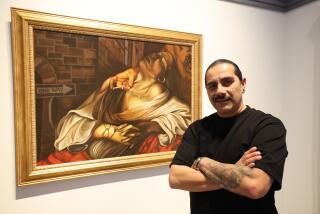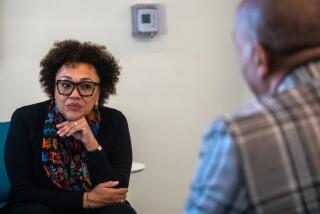Cubans Wifredo Lam and Carlos Luna showcased at Museum of Latin American Art
TWO OF Cuba’s artistic exports -- 20th century Modernist Wifredo Lam and emerging artist Carlos Luna -- have landed side by side at Long Beach’s Museum of Latin American Art, in shows offering two variations on the theme of Cuban identity.
“The identity of being Cuban is not a one-way road,” says painter and sculptor Carlos Luna, via his wife and translator, Claudia. After all, modern Cuba is a conglomeration of Spanish, African and Indian elements, a mixed culture influenced by slave trading and the international sugar cane market. And though the works of Luna and the late Lam may differ in focus and style, Luna says, they both address “a very essential part of Cuban life, which stems from certain traditions and mixture.”
The artists also share a similar knack for wandering, both willingly and un-.
The 39-year-old Luna left Cuba in 1990, spending more years in Mexico than he intended to before settling down in Miami. His works concentrate on the figure of the guajiro -- or what he calls the average Joes of Cuba, guys like himself who grew up simply in the countryside. In typical fashion, his oil painting “Arbol Grande, Guajiro Yo” plays heavily upon his own personal history, taking as its point of departure a conversation between Luna and his grandparents.
“The title means ‘Big tree, I am a guajiro,’ ” he says. “My grandfather used to tell me, if I want to grow up to be big and important, I couldn’t be under the shadow of someone else.”
With its tobacco-smoking protagonist and thick tree roots, he says, it also incorporates one of the artist’s favored tropes, a deep connection to his culture of origin. “A man without a past is a man with no future,” he says.
Luna says he was partially influenced by Lam, whose complicated trajectory began in Cuba as the son of a Cantonese businessman and an indigenous Afro-Cuban mother. After receiving his initial training at home, Lam headed to Madrid, where he was steeped in the European tradition of the Old Masters -- a 15-year stay that came to an abrupt end courtesy of the Spanish Civil War.
“He was active politically and sided with the wrong side,” says exhibit curator Curtis Carter. Cue a swift departure to France, where Lam fell in with the likes of Surrealist André Breton and Pablo Picasso. Until, that is, the outbreak of World War II, when Lam returned to Cuba, and his artwork underwent a radical shift.
“He has a sort of dual citizenship, artistically. While in Paris, he was recognized as a modern Surrealist,” says Carter. “Once he went back to Cuba, he dug into his Afro-Cuban roots.” At this point, Lam began to dwell on the lush Cuban terrain and the mythic figures, demons and deities such as the femme cheval, symbolic to the Afro-Cuban religious tradition.
At the war’s end, Lam sailed back to Paris, visiting the U.S. periodically over the next nearly four decades of his life. All this back and forth, Carter says, bred a blending of European and Latin American traditions that’s led to two schools of thought on his work -- a European coterie who saw Lam first as a Surrealist interweaving Afro-Cuban elements, and Latin American intellectuals who placed him more firmly within the local tradition of magical realism. “They’re both right,” Carter says. “I describe Lam as a cultural globalizer.”
In Lam’s abstracted work, Luna sees a familiar Cuban landscape. What’s missing, he says, are the Cubans and life as lived on the island: “I am like a chronicler. I’m constantly talking about that.”
While Lam’s pro-revolutionary leanings led him to be portrayed as a Castro sympathizer -- unfairly, Carter believes -- there can be no mistaking Luna’s own stance. A panel of his epic work “El Gran Mambo,” from which his half of the MOLAA shows takes its name, depicts the artist’s alter ego urinating on Fidel’s decapitated noggin.
‘WIFREDO LAM IN NORTH AMERICA’ AND ‘CARLOS LUNA: EL GRAN MAMBO’ WHERE: Museum of Latin American Art, 628 Alamitos Ave., Long BeachWHEN: Opens Sun. Ends Aug. 31.PRICE: $7.50; free on Fridays and SundaysINFO: (562) 437-1689, molaa.org
More to Read
Start your day right
Sign up for Essential California for news, features and recommendations from the L.A. Times and beyond in your inbox six days a week.
You may occasionally receive promotional content from the Los Angeles Times.






